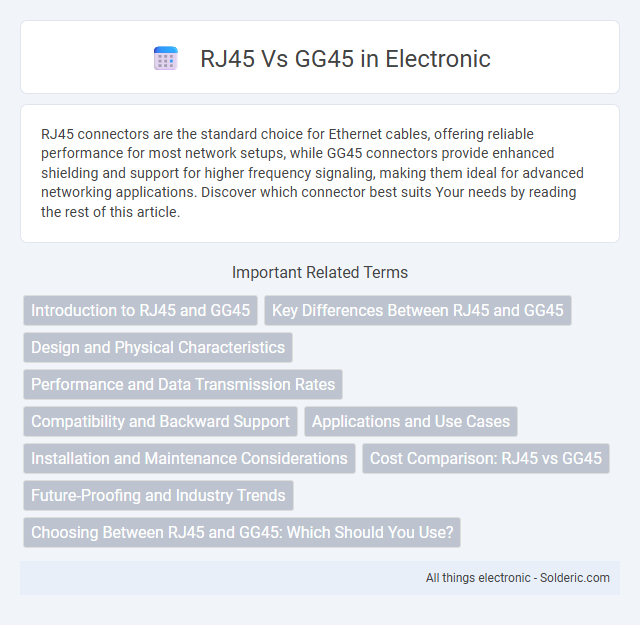RJ45 connectors are the standard choice for Ethernet cables, offering reliable performance for most network setups, while GG45 connectors provide enhanced shielding and support for higher frequency signaling, making them ideal for advanced networking applications. Discover which connector best suits Your needs by reading the rest of this article.
Comparison Table
| Feature | RJ45 | GG45 |
|---|---|---|
| Connector Type | Standard 8P8C Modular Connector | Enhanced 12P8C Modular Connector |
| Maximum Data Rate | Up to 10 Gbps (Cat 6a) | Up to 40 Gbps (Cat 7/Cat 7a) |
| Backward Compatibility | Works with older Ethernet standards | Compatible with RJ45 plugs |
| Shielding | Typically UTP or shielded twisted pair | Improved shielding for reduced crosstalk and interference |
| Use Case | Common in residential and office Ethernet installations | High-performance networks, data centers, and enterprise |
| Standard | IEC 60603-7 | IEC 61076-3-110 |
Introduction to RJ45 and GG45
RJ45 is the standard connector used widely in Ethernet networking, supporting data transmission speeds up to 10 Gbps over twisted-pair cables. GG45, an advanced connector compatible with RJ45, offers improved performance for high-speed data transfer, especially in Category 7 and above cabling systems. Your network infrastructure can benefit from GG45's superior shielding and crosstalk reduction, making it ideal for future-proofing high-bandwidth applications.
Key Differences Between RJ45 and GG45
The key differences between RJ45 and GG45 connectors lie in their design and performance capabilities, with RJ45 supporting up to Cat6A speeds and GG45 engineered for higher frequencies up to 600 MHz, accommodating Cat7 and Cat7A standards. GG45 features augmented shielding and additional contacts for improved crosstalk reduction and superior signal integrity compared to the traditional RJ45. When upgrading Your network infrastructure, GG45 offers a future-proof solution for higher bandwidth requirements, while RJ45 remains widely compatible and cost-effective for standard Ethernet connections.
Design and Physical Characteristics
The RJ45 connector features an 8-position, 8-contact modular design commonly used for Ethernet cables, with a compact size that fits standard networking devices. The GG45 connector, designed for higher performance, incorporates additional contacts and supports both RJ45 backward compatibility and enhanced signal separation through its shielded twisted pair cables. GG45's physical design includes a larger form factor and improved contact layout to reduce crosstalk and support frequencies up to 600 MHz, ideal for high-speed data transmission beyond traditional RJ45 capabilities.
Performance and Data Transmission Rates
RJ45 connectors support data transmission rates up to 1 Gbps in standard Ethernet applications, making them suitable for most home and office networks. GG45 connectors, designed for higher performance, accommodate frequencies up to 600 MHz and provide data rates exceeding 10 Gbps, ideal for advanced networking environments requiring enhanced bandwidth and reduced crosstalk. Your choice between RJ45 and GG45 impacts network speed and reliability based on the required data transmission performance.
Compatibility and Backward Support
RJ45 connectors maintain broad compatibility with existing Ethernet cables and are fully supported by most network devices, ensuring seamless integration in legacy systems. GG45 connectors, designed for enhanced performance in high-speed applications, offer backward compatibility by accepting standard RJ45 plugs, allowing gradual network upgrades without complete infrastructure replacement. This interoperability enables smooth transition paths from Cat5e and Cat6 standards to advanced Cat7 and beyond, preserving investment in cabling while improving bandwidth capabilities.
Applications and Use Cases
RJ45 connectors are widely used in traditional Ethernet networks, supporting speeds up to 10 Gbps for residential and office applications. GG45 connectors, designed for high-speed data transmission, are commonly deployed in advanced networking environments and data centers where 40 Gbps and higher bandwidth is required. Your choice between RJ45 and GG45 depends on the network speed needs and the infrastructure environment, with GG45 offering future-proofing for high-performance communication systems.
Installation and Maintenance Considerations
RJ45 connectors offer straightforward installation with standardized tools and widespread compatibility, making maintenance simpler and more cost-effective for typical Ethernet networks. GG45 connectors, designed for higher frequency applications up to 40 Gbps, require more precise installation techniques and specialized tools, which can increase setup time and maintenance complexity. Your decision between RJ45 and GG45 should factor in the balance between ease of installation and the need for high-speed performance in your network infrastructure.
Cost Comparison: RJ45 vs GG45
The RJ45 connector remains significantly more cost-effective than the GG45, with RJ45 prices typically ranging from $0.30 to $1.50 per unit, while GG45 connectors often start around $5 and can exceed $10 due to advanced design and higher performance capabilities. RJ45 is widely used in standard Ethernet applications, benefiting from mass production economies, whereas GG45 targets specialized high-speed networks like 10GBASE-T and above, driving its higher price point. Organizations must weigh the cost-benefit trade-offs between the affordability of RJ45 and the superior bandwidth and future-proofing provided by GG45 connectors.
Future-Proofing and Industry Trends
GG45 connectors offer enhanced shielding and support higher frequencies up to 600 MHz compared to the RJ45's 100 MHz, making them a future-proof choice for emerging 40G Ethernet networks. Industry trends show increasing adoption of GG45 in data centers and high-speed applications, ensuring your cabling infrastructure can handle next-gen protocols without costly upgrades. Investing in GG45 today aligns with evolving standards and maximizes network longevity and performance.
Choosing Between RJ45 and GG45: Which Should You Use?
Choosing between RJ45 and GG45 connectors depends on the network requirements and future-proofing needs; RJ45 remains the standard for most Ethernet applications, supporting up to Cat6A speeds of 10 Gbps over 100 meters. GG45 connectors offer backward compatibility with RJ45 while supporting higher frequencies up to 1.2 GHz, enabling 10 Gigabit Ethernet and beyond in shielded twisted pair (STP) cabling environments. For environments demanding superior data transmission rates and reduced crosstalk, GG45 is ideal, but RJ45 remains widely used for cost-effective, broad compatibility in standard networking setups.
RJ45 vs GG45 Infographic

 solderic.com
solderic.com